When this paper was founded 140 years ago, Dallas was more small town than city, with the occasional cattle stampede running through its unpaved streets. One of the few known photographs of our first home, a three-story block on Commerce Street, shows a man parking in front of the building — on horseback. The city has changed over the ensuing years, but one thing hasn’t: Downtown has always been home to The Dallas Morning News, even if our offices have hopscotched around a few times.
That first building was a modest if handsome brick structure built around 1885. It was typical of the commercial architecture of the period, but for a bit of flamboyance on its roof: a little temple front that sat above a marquee with “The Dallas News” spelled out in our now-familiar Gothic letters.

The Dallas News building on Commerce Street, ca. 1880s.
DeGolyer Library, SMU
That building burned around the turn of the century and was replaced by a new home on the corner of Commerce and Lamar streets. Also three stories tall, but significantly larger than its predecessor, the building reflected the success of both the paper and the city it covered. It was far more opulent than the building it replaced, with stone detailing and eagle-topped decorative finials along its cornice line.
News Roundups
The main entry was in a slightly inset bay facing Lamar Street, marked on its third floor by a Palladian window. Within, the building was divided into two sections, with the presses and other mechanical equipment on one side, and the administrative and news operations on the other. The newsroom was a broad open space with high coffered ceilings supported by marble columns with elaborate capitals. A lobby had teller windows where visitors could place subscription orders and purchase ads.
The structure played a significant role in the life of the city. On special occasions, it was festooned with bunting, and on typical days a cross section of the public could be found taking advantage of the shade beneath the striped canopies that lined its street fronts. In case anyone wondered about the occupant of the building, a large sign reading “The News” in all caps projected from its prime corner, with bubble lights in its letters so that the name shone brightly at night.
In a sense, the building was an advertisement for the paper. “Newspapers used their buildings to attract attention,” said architecture critic Inga Saffron, who is writing a book on the history of newspaper buildings. “They wanted their readers to see them in their field of vision as they progressed through the city.”
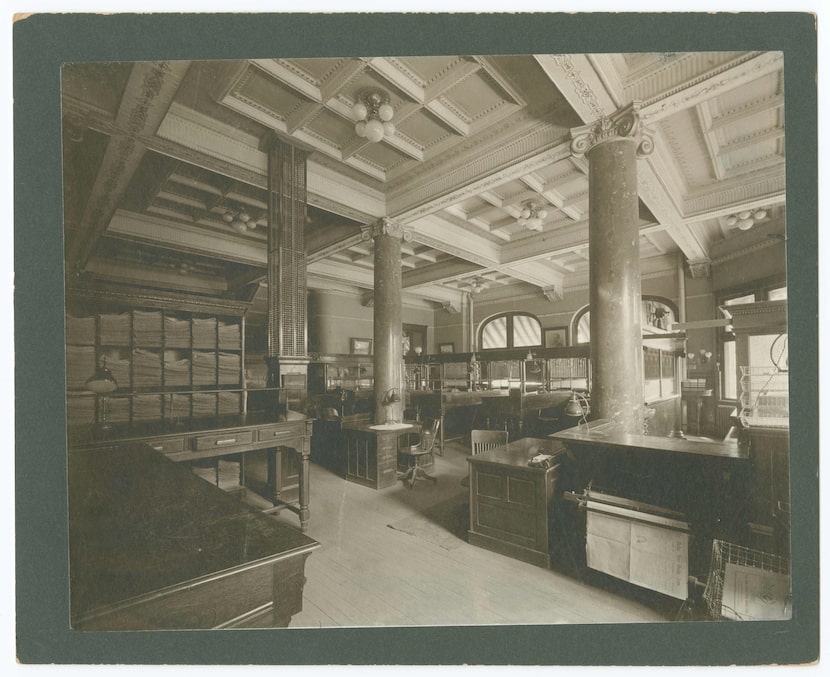
The paper’s newsroom, ca. 1903-05.
DeGolyer Library, SMU
The News further embraced that imperative in 1949, when it moved to the building with which it remains most closely associated, the so-called Rock of Truth facing Young Street and Ferris Plaza. That name was drawn from the massive inscribed tablet that commands its front facade. “Build the news upon the rock of truth and righteousness,” it reads. “Conduct it always upon the lines of fairness and integrity. Acknowledge the right of the people to get from the newspaper both sides of every important question.”

The Dallas Morning News staff group photo in front of the Rock of Truth, photographed April 13, 2017.
Evans Caglage / Staff Photographer
The architecture spoke as loudly as the writing on that stone wall. While the previous news buildings had been fairly conventional commercial structures, this one was something else: a statement of Olympian grandeur, authoritatively set back from the street behind a broad flight of steps. The moderne design was the work of George Dahl, the city’s most prolific architect of public buildings, who had led the design team behind the 1936 Texas Centennial Exposition at Fair Park.
Visitors entered the building through a magnificent lobby, a double-height space with a Texas star in its marble floor. At the rear, elevators boasted bronze seals of both the Republic of Texas and the state of Texas. But the showstopping feature was an immense mural by Perry Nichols, a member of the circle of regionalist artists known as the Dallas Nine. It told the conjoined histories of The News and Texas, with images of Confederate soldiers and slaves that today seem wildly inappropriate. (It is now part of the collection at the University of Texas at Austin.)
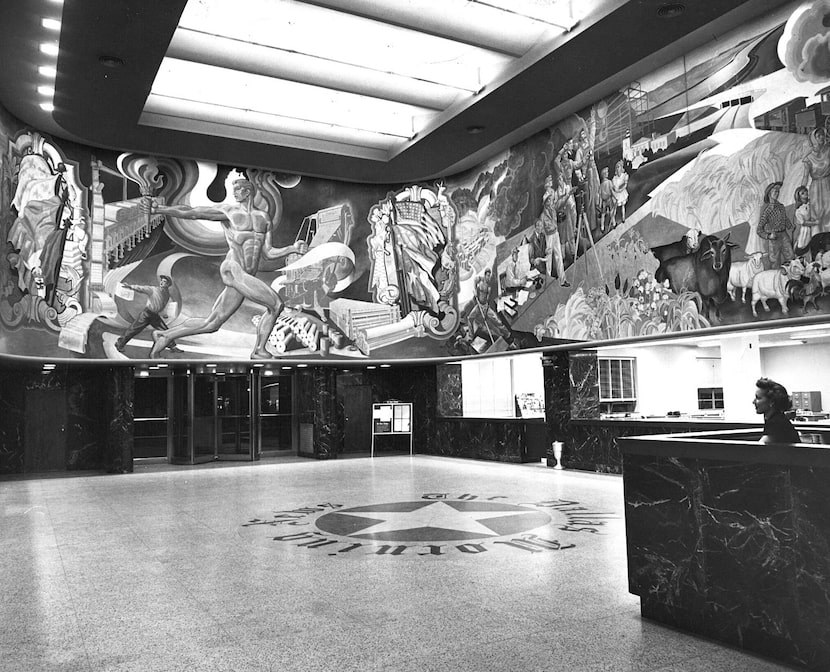
A mural by Perry Nichols once wrapped around the lobby of the Young Street building. The mural is now in the collection at the University of Texas at Austin.
“Nowhere in the nation will one find so complete a newspaper plant with so many facilities expertly provided for,” said Dahl, when it opened. It is telling that he called it a plant. The building was as much a factory as an office. The paper was printed there, on three 350-ton presses, each three stories tall and 150 feet long, that could spit out 2,000 papers a second. The weight of those machines required reinforced floors with oversized steel girders, specialized ventilation systems and a variety of other works of complex mechanical engineering.
For 68 years, the Rock of Truth was the paper’s home, though its grandeur was severely diminished by an unfortunate interior renovation in the 1960s. Over time, the clacking of typewriters was replaced by the clicking of computer keyboards, and much of the building was emptied out, with printing moved to a plant in Plano and a slow reduction in staff as the newspaper industry adjusted to economic and technological realities. In its final years as the paper’s home, it was a depressing maze of half-abandoned Dilbert cubicles and frayed carpet. Nearly a decade after our departure, its future remains an open question.
In 2017, the paper moved back to Commerce Street, departing the Rock of Truth for the space it now occupies, the former Dallas Public Library building. Opened in 1955, the four-story work of midcentury modernism was also designed by Dahl, but had sat vacant for years. Fronted by broad glass windows, and with a news ticker visible to passersby, the transformed library opened the paper up to the public it serves. Transparency, a hallmark of midcentury architecture, testified to material and structural honesty, an appropriate metaphor for a home for independent journalism.
The paper could not take the Rock of Truth to the library, but it is not totally gone. A replica with aluminum letters on a backlit plastic panel now welcomes visitors. No longer a commanding pronouncement from on high, it seems more like a fitting acknowledgment of the paper’s history. Beyond the lobby, the double-height space that was the library’s reading room and stacks has been converted into a bullpen-style newsroom.
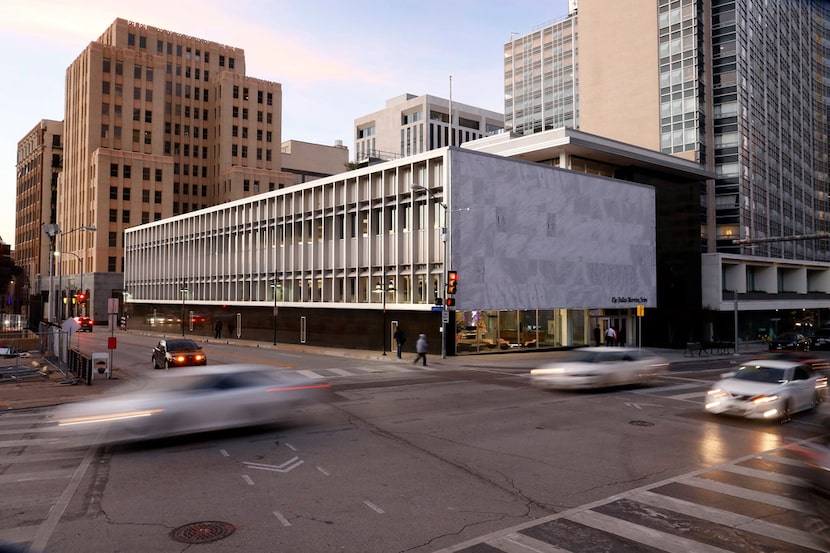
In 2017, The Dallas Morning News moved back to Commerce Street, this time into the former Dallas Public Library building.
Tom Fox / Staff Photographer
Open stairwells provide access to a mezzanine level that overlooks the floor below, and the reporting staff is concentrated on these two floors. Top editors and executives are situated in glass-fronted cubicles — no grand, walnut-paneled offices here. A roof terrace offers views of the Dallas skyline, another benefit of the paper’s change of address. The move not only represents a revival of the long-dormant library, but also of the broader regeneration of the area around Main Street Garden. The neighboring Statler Hotel is again alive, as is the restored beaux arts Municipal Building.
In May 1949, in one of a series of articles celebrating the debut of the paper’s then-new home, columnist Lynn Landrum imagined what might come of the paper in 50 years. “Nobody even knows that we shall have newspapers at all in 1999,” he wrote. “Maybe you will have a battery of buttons on a cabinet and will tune in on any newspaper office in the world and begin to get stock markets from New York, art criticism from Rome, sports from Dallas and editorials from London.”
Landrum wasn’t too far off, but happily The News is still in operation and still making its home in a downtown building that was constructed as a repository for the dissemination of knowledge. The old library is once more dedicated to that mission, a physical embodiment of that effort in an era of digitized information and instant communication.
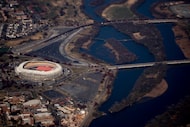 Dallas-based firm HKS tapped to design stadium for Cowboys rival
Dallas-based firm HKS tapped to design stadium for Cowboys rival
HKS’ work includes AT&T Stadium in Arlington and the upcoming Children’s Health hospital in Dallas.
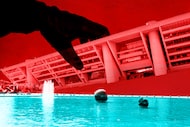 Lamster: Plans to abandon Dallas City Hall are a tragic farce
Lamster: Plans to abandon Dallas City Hall are a tragic farce
City leaders seem bent on leaving the iconic building without consulting voters.